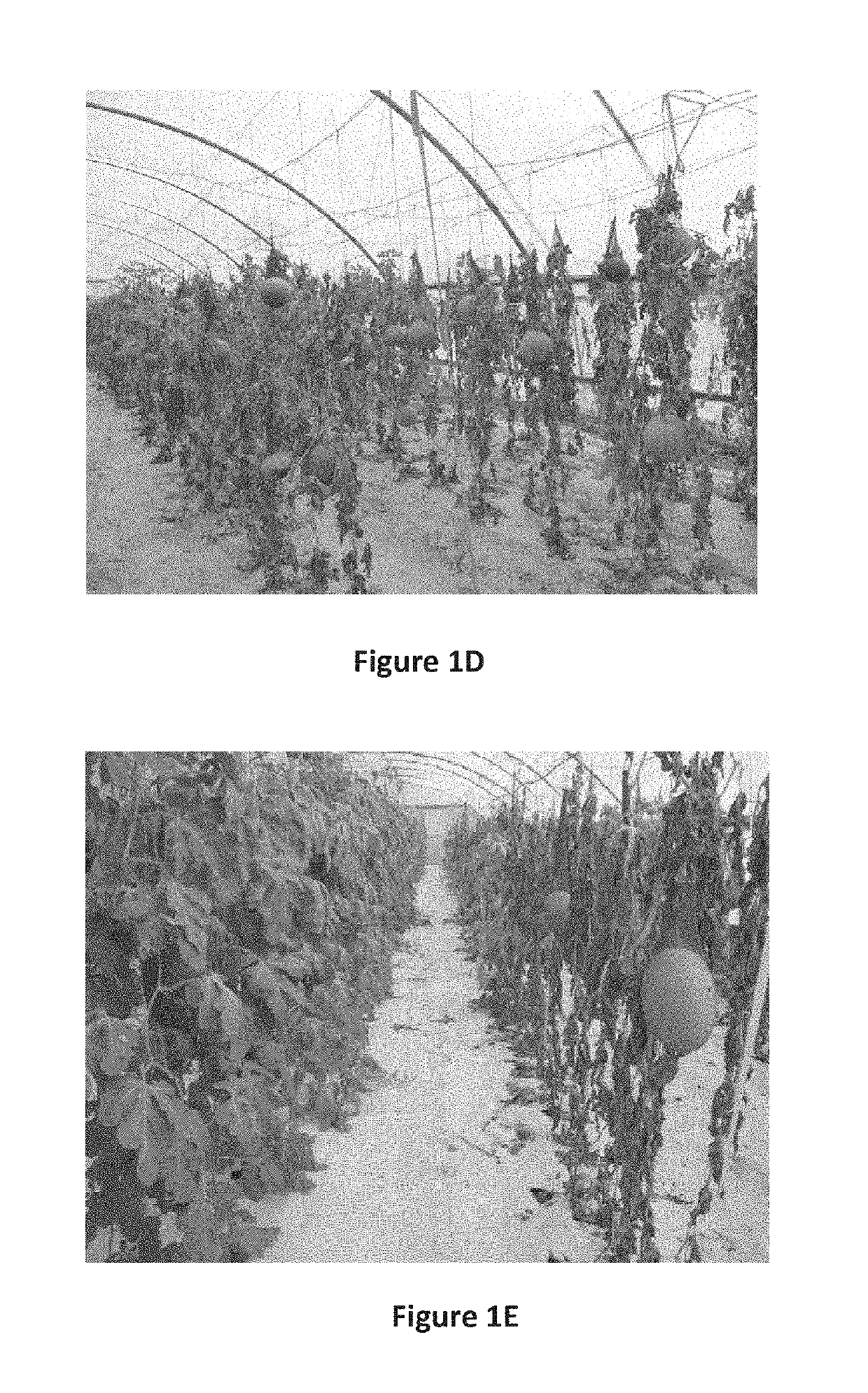Watermelon plants with tolerance to powdery mildew
a technology of watermelon plants and powdery mildew, applied in the field of watermelon plants, can solve the problems of affecting the growth of watermelon plants, and affecting the growth of watermelon,
- Summary
- Abstract
- Description
- Claims
- Application Information
AI Technical Summary
Benefits of technology
Problems solved by technology
Method used
Image
Examples
example 1
n of Mini Seedless Triploid Watermelons
[0178]The target of this breeding was to develop mini seedless watermelon hybrids tolerant to PM, using the genetic background of PI 482312. Unless otherwise stated, all breeding stages were conducted in plastic greenhouses in Bnei Darom, Israel.
The Male Parent Lines
[0179]PI 482312 is a watermelon (Citrullus lanatus var. Citroides) line known to have tolerance to powdery mildew (PM). This PI was obtained from the plant genetic resources unit, Griffin, Georgia, originally from Zimbabwe. PI 482312 exhibited heterogeneity in PM tolerance. Therefore, selections of self pollination of this PI line was conducted to obtain a line homogeneous for high level of PM resistance (i.e. in a scale of between 1 to 10, to a level of 8-9), and this line is referred to herein as PI 482312. To this end, the plants of PI 482312 were routinely grown in plastic greenhouse during the years 2005-2012, in two seasons per year, winter and summer During the routine growth...
example 2
n of Triploid Mini Seedless Watermelon with PM Tolerance—Development Stages (Year Description)
[0227]The target of this breeding was to develop seedless watermelon hybrids tolerant to PM, using the genetic background of PI 482312 as described above. Unless otherwise stated, all breeding stages were conducted in plastic greenhouses in the southern areas of Israel. Breeding stages were similar to those described in Example 1 above.
[0228]The following breeding lines were exposed to PM and those showing best tolerance were selected (by scoring, see below). Specifically, the plants were grown in a greenhouse and were inoculated by spreading uniformly the fungus by hand in the greenhouse. The plants in the greenhouse were not treated with fungicides at all. In a scale from 1 to 9 (9 being the best performance of PM tolerance), the male parent line exhibited tolerance to PMW1 of 7-8 and three male parent line exhibited tolerance to PMW2 of 7-8.
[0229]The breeding pathway is also illustrated ...
example 3
roductions of Triploid Seedless Watermelon with PM Tolerance—Development Stages
12.702b Pathway:
[0241]Summer 2008: A cross have been taken with two Origene Seeds proprietary lines: “237a4” being PM sensitive (PMS) and “406” being PM resistant (PMR, described hereinabove) to create the line “554-F1”.
[0242]Summer 2010: A backcross between “554-F5” and Origene Seeds proprietary line “112” (described hereinbefore) was made to create “572-F1”.
[0243]Winter 2012: A cross between the diploid line “572-b-F5” (PMR) as a male and Origene Seeds Proprietary tetraploid line “612a” (PMS) as a female to create the triploid hybrid “12.702b”. This hybrid was created also in winter 2014 with “572-b-F9” and “612a” and was deposited under NCIMB 42359.
12135b Pathway:
[0244]Summer 2007: A cross have been made with two Origene Seeds proprietary lines: “ZGM” being PM sensitive (PMS) and “406” being PM resistant (PMR) to create the line “538-F1”.
[0245]Winter 2010: A second backcross have been made between “538...
PUM
| Property | Measurement | Unit |
|---|---|---|
| diameter | aaaaa | aaaaa |
| temperature | aaaaa | aaaaa |
| weight | aaaaa | aaaaa |
Abstract
Description
Claims
Application Information
 Login to View More
Login to View More - R&D
- Intellectual Property
- Life Sciences
- Materials
- Tech Scout
- Unparalleled Data Quality
- Higher Quality Content
- 60% Fewer Hallucinations
Browse by: Latest US Patents, China's latest patents, Technical Efficacy Thesaurus, Application Domain, Technology Topic, Popular Technical Reports.
© 2025 PatSnap. All rights reserved.Legal|Privacy policy|Modern Slavery Act Transparency Statement|Sitemap|About US| Contact US: help@patsnap.com



